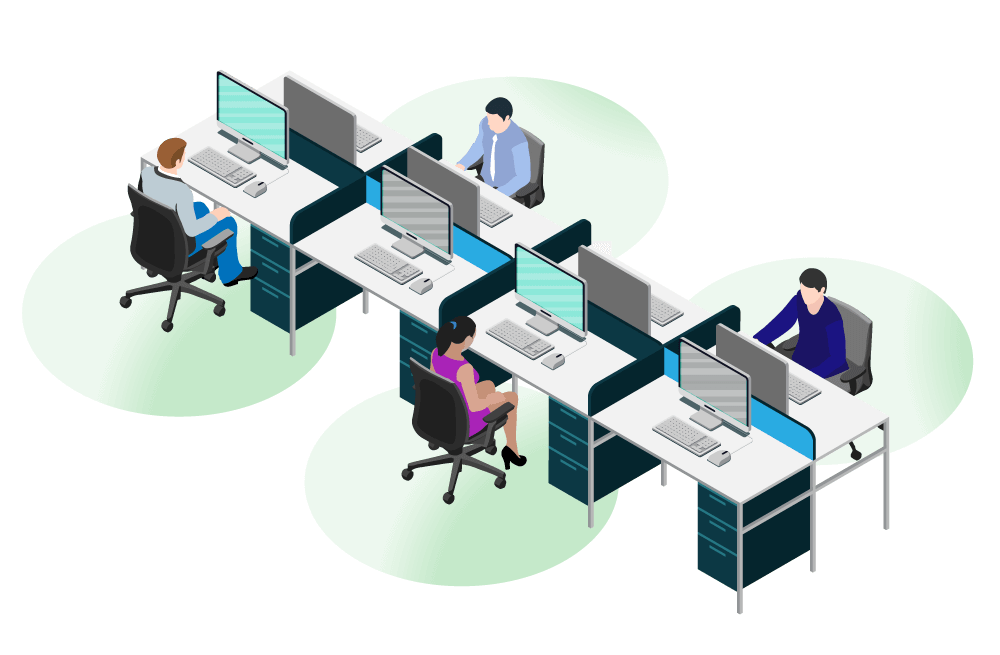
One of the back-to-the-physical office transition tactics that have received a lot of attention lately is shift work.
With shift work, employees would be placed into groups, and only specific groups would be permitted to work in the office at a time (or during their shift). What is shift seating? Shift seating refers to employees occupying the workspace in shifts while at assigned desks.
Though this is a great way to reduce the number of people heading back into the office at a time, what’s the best way for facility managers (FMs) to approach this logistically?
In this post, we’re exploring how companies can best roll out a shift work schedule that keeps employees safe and doesn’t create a massive headache for the facility management team and other company leaders.
How can shift work help slow the spread of the coronavirus in the workplace?
We know that physical distancing is one of the most impactful ways to mitigate the coronavirus spread. Therefore, limiting the number of people allowed back into the office can have a significant effect on the rate of spread—and possibly stop it from entering the office altogether.
Also, not only are you reducing the number of people in your office at once, but it can help the cleaning team keep up with demand and ensure they’re cleaning the right areas based on shift activity.
Depending on how many people your company employs, shift work could be one of the best solutions to ensure a safe transition back to the office. Let’s take a look at a few ways FMs can implement shift work into their office transition plans.
Strategies for executing shift work
How you approach your company’s shift work will largely depend on your company’s size and space. If your company is on the larger side, it may make sense to divide employees into several groups.
Keep in mind, when dividing employees, be sure to distribute employees from each department to each group. That way, if one employee gets sick, they don’t accidentally wipe out an entire department.
One popular shiftwork strategy that has garnered attention recently is the 10-4 method. This model entails employees rotating between the office and working from home in two separate shifts, like so:
Shift 1: Work at the office for four days
Shift 2: Work from home for ten days
The main idea is that if an employee comes into contact with the coronavirus, their symptoms will begin to show during their 10-day work-from-home shift rather than at the office, risking exposing others. This also gives employees the chance to get proper medical treatment while they continue their at-home isolation to prevent the spread of their symptoms.
Another approach involves employees working on alternating days during the week. This could look like:
Week 1: Work Monday/Wednesday/Friday from the office
Week 2: Work Tuesday/Thursday from the office
With this approach, employees could also be scheduled on alternating weeks, which brings 50% of the staff back into the office at a time. This approach would warrant additional cleaning measures between shifts, so if you opt for this method, be sure to account for additional cleaning requirements.
How can FMs manage shift work?
Shift work sounds excellent, in theory. But without proper logistics in place, it has the potential to become challenging to oversee.
So how can FMs manage this?
There are numerous ways FMs can plan and execute a successful shiftwork strategy, including:
Use remote desk booking
Before employees show up to the office for their shift, have them book their desks for the duration of their shift using remote desk booking software. This is also an excellent way for you to verify that the right employees are counting on showing up to work.
Implement desk sensors
Desk sensors can help you see which employees are actually at their desks, which allows you to see how many people are in the office at any given time. Desk sensors can also help confirm that the right people from the current shift are present. Sensors can act as a check-in system that verifies that the right employee is present in the office.
Leverage your Visual Directory® tool
In the initial planning stage, your visual directory tool can serve as a guide to help you figure out the best way to rearrange desks, shared spaces, and other high-traffic areas. This tool can also help you determine your maximum utilization capacity, which can help you when grouping employees into shifts.

Days vs. weeks: which is best?
If you do choose to implement shift work as part of your back-to-the-office strategy, remember that there’s no one way to approach it. What works for your company might not work for another company and vice versa.
The top priority is to ensure your employees are safe and practicing physical distancing while in the workplace. If nothing else, break your employees into small groups and know your maximum utilization capacity to ensure you aren’t allowing too many people back at once.
How is your team handling the transition back into the workplace? Leave a comment below or send us a Tweet to let us know how you’re doing.
Photo Credits: Eric Rothermel, energepic, OSS




